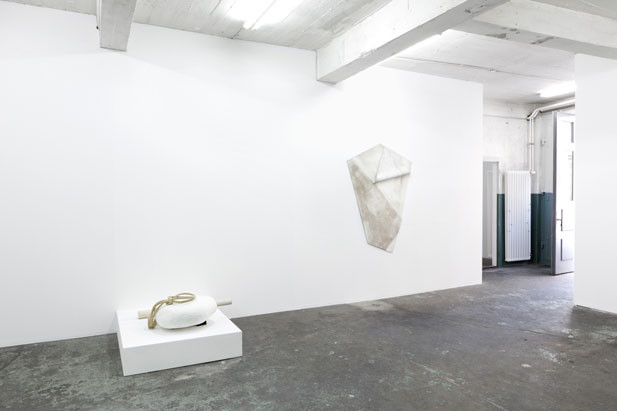Sophie Bueno-Boutellier
25 Aug - 02 Oct 2011
SOPHIE BUENO-BOUTELLIER
Adriatique ... 3h du matin
25 August – 2 October
Various cultural reference and artistic styles converge in the oeuvre of French Artist Sophie Bueno-Boutellier (*1974, F, lives in Berlin) that she confers to form with great subtlety. In their minimalist aesthetics her works evoke historical minimalism and with their often „poor“ materiality recall Arte Povera, moving on the segue between categories of painting, sculpture, ready-made and installation. Appeals to the aesthetics of minimalism can be interrupted by the evident craftwork of the artist who for example paints canvases monochrome with pale colours, folds the canvases accurately and applies them to the wall like a piece of clothing, thus making the fabric become a sculpture: a possibility of treating the material of canvas that can be implemented as a destructive gesture on historical parameters of painting since the 1960s.
Organic materials such as clay or a thick root may serve Bueno-Boutellier as working material that she arranges with precious raw material to distinctive installations. The minimalist figure of Bueno-Boutellier‘s works is due to the staged precision with which she arranges the works within a space, also to the accurateness of their execution and their impression of never allowing a „too much“. The play with the contrariness of organic, tactile - haptic and precious materials that the artist arranges in austere installations without any appearance of coincidence attributes to a specific aesthetic potency that at times recalls the atmosphere of Japanese gardens. Effects like „Emptiness“ and „Silence“ are evoked that possibly can be understood as „archaic“ or „sublime“.
The works not only manifest material or medial references to art history as well as an immanent potential of affect that derives from the haptic quality of many of their elements.
The lose recourses to literary and other sources outside the field of art, such as the concept of repetition of Gertrude Stein (1874-1946), multiply the viewer‘s options of interpretation.
Bueno-Boutellier‘s approaches resemble a strategy of ambiguisation that reflects in a tendency to seemingly speak vaguely about the artist‘s works. Her works can be integrated in the theories around the concept of „The Open Work“, which seen historically has existed for several hundreds of years before Umberto Eco added new critical nuances to in the 1970s.
The concept of signifying polysemy and the overdetermination of the art work have today advanced to be the specific of contemporary art and the ubiquitary topos of art criticism.
In this context the works of Bueno-Boutellier are distinguished exactly by not disguising the diversity of recourses, references and the broad offering of interpretation they provide, but by flaunting them with quiet gestures.
Adriatique ... 3h du matin
25 August – 2 October
Various cultural reference and artistic styles converge in the oeuvre of French Artist Sophie Bueno-Boutellier (*1974, F, lives in Berlin) that she confers to form with great subtlety. In their minimalist aesthetics her works evoke historical minimalism and with their often „poor“ materiality recall Arte Povera, moving on the segue between categories of painting, sculpture, ready-made and installation. Appeals to the aesthetics of minimalism can be interrupted by the evident craftwork of the artist who for example paints canvases monochrome with pale colours, folds the canvases accurately and applies them to the wall like a piece of clothing, thus making the fabric become a sculpture: a possibility of treating the material of canvas that can be implemented as a destructive gesture on historical parameters of painting since the 1960s.
Organic materials such as clay or a thick root may serve Bueno-Boutellier as working material that she arranges with precious raw material to distinctive installations. The minimalist figure of Bueno-Boutellier‘s works is due to the staged precision with which she arranges the works within a space, also to the accurateness of their execution and their impression of never allowing a „too much“. The play with the contrariness of organic, tactile - haptic and precious materials that the artist arranges in austere installations without any appearance of coincidence attributes to a specific aesthetic potency that at times recalls the atmosphere of Japanese gardens. Effects like „Emptiness“ and „Silence“ are evoked that possibly can be understood as „archaic“ or „sublime“.
The works not only manifest material or medial references to art history as well as an immanent potential of affect that derives from the haptic quality of many of their elements.
The lose recourses to literary and other sources outside the field of art, such as the concept of repetition of Gertrude Stein (1874-1946), multiply the viewer‘s options of interpretation.
Bueno-Boutellier‘s approaches resemble a strategy of ambiguisation that reflects in a tendency to seemingly speak vaguely about the artist‘s works. Her works can be integrated in the theories around the concept of „The Open Work“, which seen historically has existed for several hundreds of years before Umberto Eco added new critical nuances to in the 1970s.
The concept of signifying polysemy and the overdetermination of the art work have today advanced to be the specific of contemporary art and the ubiquitary topos of art criticism.
In this context the works of Bueno-Boutellier are distinguished exactly by not disguising the diversity of recourses, references and the broad offering of interpretation they provide, but by flaunting them with quiet gestures.

